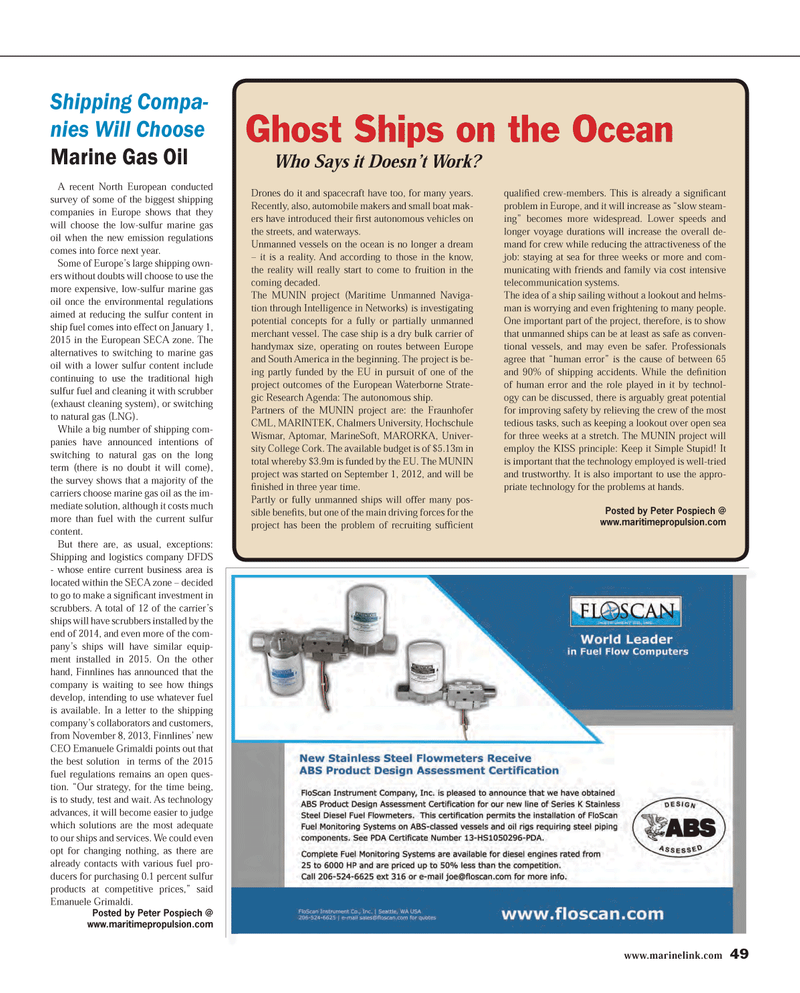
Page 49: of Maritime Reporter Magazine (February 2014)
Cruise Shipping Edition
Read this page in Pdf, Flash or Html5 edition of February 2014 Maritime Reporter Magazine
www.marinelink.com 49
Ghost Ships on the Ocean Who Says it Doesn’t Work?
Drones do it and spacecraft have too, for many years.
Recently, also, automobile makers and small boat mak- ers have introduced their fi rst autonomous vehicles on the streets, and waterways.
Unmanned vessels on the ocean is no longer a dream – it is a reality. And according to those in the know, the reality will really start to come to fruition in the coming decaded.
The MUNIN project (Maritime Unmanned Naviga- tion through Intelligence in Networks) is investigating potential concepts for a fully or partially unmanned merchant vessel. The case ship is a dry bulk carrier of handymax size, operating on routes between Europe and South America in the beginning. The project is be- ing partly funded by the EU in pursuit of one of the project outcomes of the European Waterborne Strate- gic Research Agenda: The autonomous ship.
Partners of the MUNIN project are: the Fraunhofer
CML, MARINTEK, Chalmers University, Hochschule
Wismar, Aptomar, MarineSoft, MARORKA, Univer- sity College Cork. The available budget is of $5.13m in total whereby $3.9m is funded by the EU. The MUNIN project was started on September 1, 2012, and will be fi nished in three year time.
Partly or fully unmanned ships will offer many pos- sible benefi ts, but one of the main driving forces for the project has been the problem of recruiting suffi cient qualifi ed crew-members. This is already a signifi cant problem in Europe, and it will increase as “slow steam- ing” becomes more widespread. Lower speeds and longer voyage durations will increase the overall de- mand for crew while reducing the attractiveness of the job: staying at sea for three weeks or more and com- municating with friends and family via cost intensive telecommunication systems.
The idea of a ship sailing without a lookout and helms- man is worrying and even frightening to many people.
One important part of the project, therefore, is to show that unmanned ships can be at least as safe as conven- tional vessels, and may even be safer. Professionals agree that “human error” is the cause of between 65 and 90% of shipping accidents. While the defi nition of human error and the role played in it by technol- ogy can be discussed, there is arguably great potential for improving safety by relieving the crew of the most tedious tasks, such as keeping a lookout over open sea for three weeks at a stretch. The MUNIN project will employ the KISS principle: Keep it Simple Stupid! It is important that the technology employed is well-tried and trustworthy. It is also important to use the appro- priate technology for the problems at hands.
Posted by Peter Pospiech @ www.maritimepropulsion.com
Shipping Compa- nies Will Choose
Marine Gas Oil
A recent North European conducted survey of some of the biggest shipping companies in Europe shows that they will choose the low-sulfur marine gas oil when the new emission regulations comes into force next year.
Some of Europe’s large shipping own- ers without doubts will choose to use the more expensive, low-sulfur marine gas oil once the environmental regulations aimed at reducing the sulfur content in ship fuel comes into effect on January 1, 2015 in the European SECA zone. The alternatives to switching to marine gas oil with a lower sulfur content include continuing to use the traditional high sulfur fuel and cleaning it with scrubber (exhaust cleaning system), or switching to natural gas (LNG).
While a big number of shipping com- panies have announced intentions of switching to natural gas on the long term (there is no doubt it will come), the survey shows that a majority of the carriers choose marine gas oil as the im- mediate solution, although it costs much more than fuel with the current sulfur content.
But there are, as usual, exceptions:
Shipping and logistics company DFDS - whose entire current business area is located within the SECA zone – decided to go to make a signifi cant investment in scrubbers. A total of 12 of the carrier’s ships will have scrubbers installed by the end of 2014, and even more of the com- pany’s ships will have similar equip- ment installed in 2015. On the other hand, Finnlines has announced that the company is waiting to see how things develop, intending to use whatever fuel is available. In a letter to the shipping company’s collaborators and customers, from November 8, 2013, Finnlines’ new
CEO Emanuele Grimaldi points out that the best solution in terms of the 2015 fuel regulations remains an open ques- tion. “Our strategy, for the time being, is to study, test and wait. As technology advances, it will become easier to judge which solutions are the most adequate to our ships and services. We could even opt for changing nothing, as there are already contacts with various fuel pro- ducers for purchasing 0.1 percent sulfur products at competitive prices,” said
Emanuele Grimaldi.
Posted by Peter Pospiech @ www.maritimepropulsion.com
MR #2 (42-49).indd 49 2/4/2014 4:46:22 PM

 48
48

 50
50
